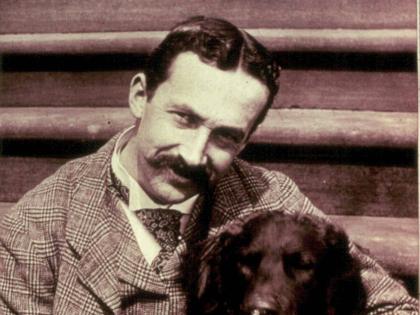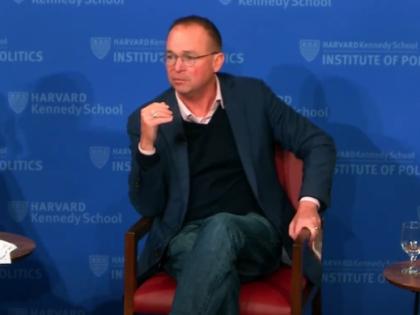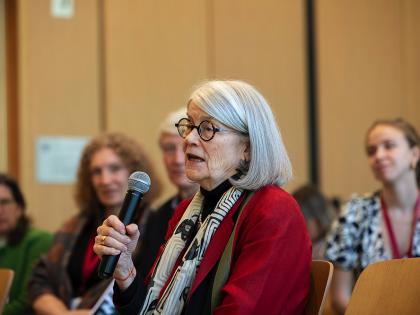Heather Watts says that she prepared for teaching her Harvard course, “George Balanchine: Ballet Master,” the same way she used to prepare for a performance at the New York City Ballet (NYCB). “At 11 a.m., I would go to the Dance Center, get my students’ responses to their reading assignments in hard copy, reread them and highlight a few, finish going over which videos we were going to watch, and then run back to my apartment. Then I’d put on a costume—plain back pants, nothing athletic or casual, different than I dress in my usual life, I’m an old hippie—and hop on my bike and get to class just in time for the curtain to go up and do it.” She laughs and confesses, “I was terrified each and every Monday.”
Her presence on campus is a sign of a burgeoning of interest in dance at Harvard and a flowering of commitment by the University administration. Watts may not have attended college herself—a Ford Foundation scholarship at the age of 13 took her to New York to study with Balanchine, and she spent 24 years dancing with his company—but her firsthand knowledge gives Harvard undergraduates and graduate students a privileged look at the works and personality of one of the great artists of the twentieth century.
“What we offer here is a blend of the experiential, the historical, and the theoretical,” says Elizabeth Bergmann, the energetic dance administrator who has led the Harvard Dance Program since 2000. A dance community that was often overlooked by the University as a whole now boasts extracurricular student troupes specializing in everything from Bhangra to ballroom, for-credit courses taught by dance professionals, and the glamorous, efficient space of the new Harvard Dance Center, which lies along the gentle swell of Observatory Hill on Garden Street and is busy from midday to midnight.
“There are 700 students using the building every week, and that’s not including audiences,” Bergmann explains. Dancing at Harvard can be a huge time commitment: some students rehearse and take classes up to 30 hours a week in addition to managing a full course load. It’s not uncommon to see a dancer stretching in the corner with a laptop open in front of her.
Though dance at Harvard may have a new visibility, it boasts a long tradition. Art connoisseur Lincoln Kirstein ’30 founded, with Balanchine, what would become the School of American Ballet and NYCB. Beginning in 1965, modern dancer Claire Mallardi ran the undergraduate dance program, expanding it to incorporate a broad variety of genres. As artistic director emerita she continues to teach “Movement for Actors,” a course she introduced in the mid 1980s.
But in 1999, the newly created Radcliffe Institute for Advanced Study announced long-range plans to reclaim in 2005 the Rieman Center for the Performing Arts, housed in the century-old gymnasium in Radcliffe Yard that had been used exclusively as dance space since 1980. “Dance had been happening there since 1898; Mark Morris taught his first choreography class in that space and the feet of Anna Sokolow, Merce Cunningham, and the Nicholas Brothers, among other greats, had touched that floor,” says Cathleen McCormick, director of programs at the Office for the Arts, which oversees all of Harvard’s ongoing arts activities, including the dance program. “We had a problem. We had dance here and we were losing our home, so we had a concrete issue we had to solve.”
 |
Courtesy of Heather Watts |
Heather Watts with Mikhail Baryshnikov |
Students rallied. “They developed a 50-page report with all kinds of statistics, press clippings, and letters from alums,” McCormick remembers, “signed by a mix of people who had gone into the arts and others who were management consultants, software developers, policy people with the World Health Organization—all advocating for dance at Harvard.” A planning committee led by associate dean of Harvard College Judith Kidd worked quickly. In September 2005, Harvard cut the ribbon on a new $4.5-million facility, designed by Bruner, Cott & Associates, a stand-alone structure that sits inside one-half of the existing multipurpose Quadrangle Recreational Athletic Center (see “Big Step,” January-Feburary 2006, page 70).
 |
Courtesy of Heather Watts |
New York City Ballet star Damian Woetzel aloft |
Proximity between studio and classroom space makes it possible for an instructor to shift easily between discussing dance and presenting it. When Christine Dakin, former principal dancer and artistic director of the Martha Graham Dance Company, taught a course on Graham’s oeuvre last spring, she was able to combine intellectual and embodied methods: “Each week I showed a film of one of Martha’s works and discussed it from historical, political, sociological, and literary directions, as well as what I had discovered about the work, what Martha had told me about the work, and what the students saw in the work. Then we did some movement explorations to let the students discover the basic principles of breath and weight and energy as she was discovering them in the 1930s. They loved it!”
Personal connection with dance professionals has made all the difference for some Harvard students. Kate Ahlborn ’07 took the initiative to cold-contact Damian Woetzel, an NYCB star (after trying seven likely permutations of his e-mail address). Ahlborn had “heard through the grapevine” that Woetzel was earning his master’s in public administration at the Kennedy School of Government with an eye toward preparing for a future career in arts policy or international affairs after his dancing days were done. Would he be willing to teach a class occasionally for the Harvard Ballet Company? Woetzel wrote back to say that he was settling into student life, but that perhaps his wife, former NYCB principal dancer Heather Watts, would be available. On a Sunday night a few weeks later, Watts taught a ballet-technique class. Ultimately Elizabeth Bergmann convinced her to teach both technique and the Balanchine seminar. When, with the approval of the Balanchine Trust, Watts set excerpts from Balanchine’s Apollo on the students, Woetzel was on hand to coach Adam Singerman ’09 in the title role.
 |
Mariah S. Evans / Harvard Crimson |
Three muses, all Harvard juniors—Madelyn Ho, Claudia Schreier, and Joanna Binney—in Balanchine’s Apollo |
“I grew up idolizing these people,” says sociology concentrator Claudia Schreier ’08, who signed up for both Dakin’s and Watts’s courses. “I grew up in Stamford, Connecticut. Damian would guest as the Cavalier in our Nutcracker, and I’d be an angel or a soldier. I never imagined that I’d be working with them at Harvard.”
A handful of dancers carry their Harvard degrees into professional dance careers. Elizabeth Waterhouse ’02, a former physics concentrator, now dances with the Forsythe Company in Dresden, Germany. Marie “Molly” Altenburg ’07, a winner of Harvard’s Suzanne Farrell Dance Prize, who danced with the Washington Ballet before enrolling at Harvard, expects to audition for ballet companies after she graduates. For many more, dancing will be a compelling avocation for the next decade or beyond.
Nonetheless, enthusiasm for dance at Harvard is not restricted to serious dancers. Watts talks about the lessons of Balanchine’s career: lessons of preparedness, of versatility, of patience, that have as much relevance to aspiring CEOs as they do to those bound for the world’s stages. “Engaging non-dancers is a major part of what we do here in the Dance Program,” notes dance program assistant Joshua Legg. “It’s about expanding perceptions. We’re mindful that some of these students will have an opportunity to be board members of foundations that might be in charge of financing arts in our society, or perhaps work with government institutions that determine arts policy.”
“When you think of dance, you don’t automatically think of Harvard,” says Kate Ahlborn. “But that there is a program in place, with performance opportunities and now credit courses, is something people should know—that, in and of itself, is an accomplishment. Our beautiful new dance center not only created a state-of-the-art facility to enjoy, but a sense of dance’s own place to grow on campus. We have a space to exist.”
Boston dance critic Debra Cash earned a master’s degree in design studies from the Graduate School of Design in 1995. A former scholar-in-residence at Jacob’s Pillow, she teaches dance history at Emerson College.









